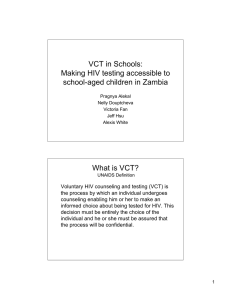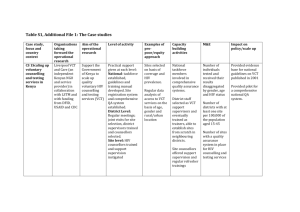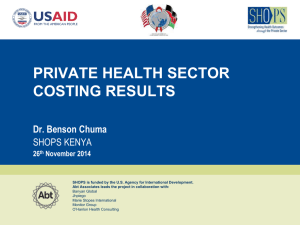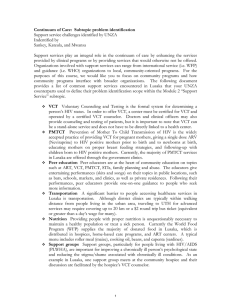A VCT Based Handover Scheme Wireless ATM Networks for
advertisement
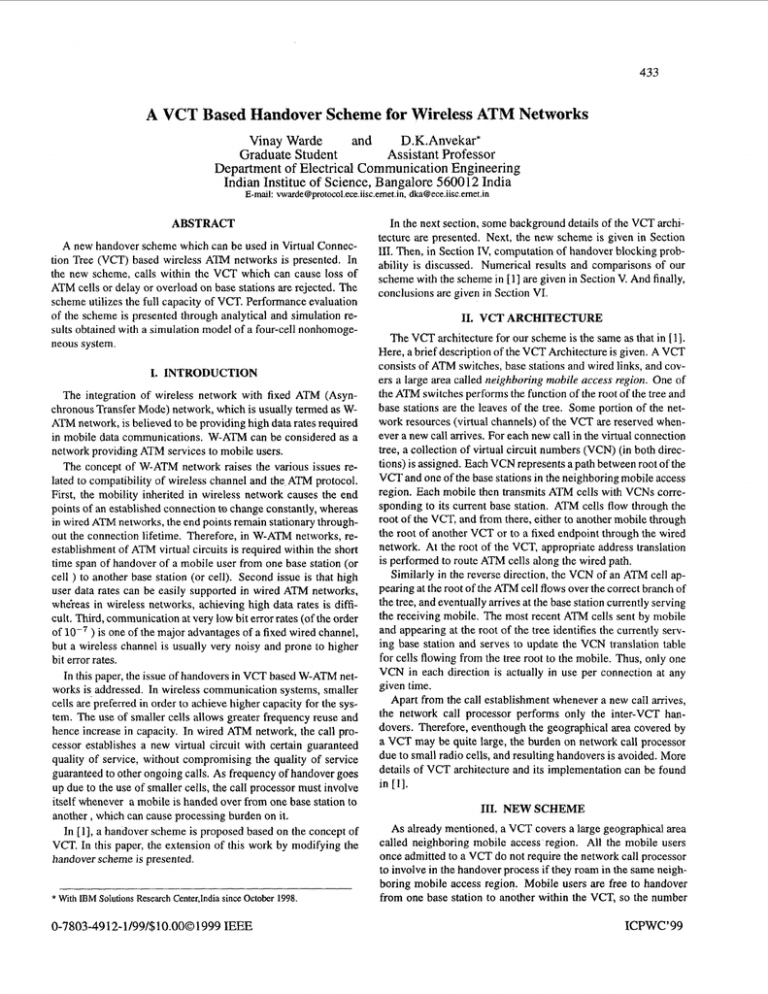
433 A VCT Based Handover Scheme for Wireless ATM Networks Vinay Warde and D.K.Anvekar* Graduate Student Assistant Professor Department of Electrical Communication Engineering Indian Institue of Science, Bangalore 560012 India E-mail: vwarde@protocol.ece.iisc.ernet.in, dka@ece.iisc.emet.in ABSTRACT A new handover scheme which can be used in Virtual Connection Tree (VCT) based wireless A'ITrl networks is presented. In the new scheme, calls within the VCT which can cause loss of ATM cells or delay or overload on base stations are rejected. The scheme utilizes the full capacity of VCT. Performance evaluation of the scheme is presented through analytical and simulation results obtained with a simulation model of a four-cell nonhomogeneous system. I. INTRODUCTION The integration of wireless network with fixed ATM (Asynchronous Transfer Mode) network, which is usually termed as WATM network, is believed to be providing high data rates required in mobile data communications. W-ATM can be considered as a network providing ATM services to mobile users. The concept of W-ATM network raises the various issues related to compatibility of wireless channel and the ATM protocol. First, the mobility inherited in wireless network causes the end points of an established connection ta change constantly, whereas in wired ATM networks, the end points remain stationary throughout the connection lifetime. Therefore, in W-ATM networks, reestablishment of ATM virtual circuits is required within the short time span of handover of a mobile user from one base station (or cell ) to another base station (or cell). Second issue is that high user data rates can be easily supported in wired ATM networks, whe'reas in wireless networks, achieving high data rates is difficult. Third, communication at very low bit error rates (of the order of ) is one of the major advantages of a fixed wired channel, but a wireless channel is usually very noisy and prone to higher bit error rates. In this paper, the issue of handovers in VCT based W-ATM networks is, addressed. In wireless communication systems, smaller cells are preferred in order to achieve higher capacity for the system. The use of smaller cells allows greater frequency reuse and hence increase in capacity. In wired ATM network, the call processor establishes a new virtual circuit with certain guaranteed quality of service, without compromising the quality of service guaranteed to other ongoing calls. As frequency of handover goes up due to the use of smaller cells, the call processor must involve itself whenever a mobile is handed over from one base station to another, which can cause processing burden on it. In [ 11, a handover scheme is proposed based on the concept of VCT. In this paper, the extension of this work by modifying the handover scheme is presented. * With IBM Solutions Research CenterJndia since October 1998. 0-7803-4912-1/99/$10.00O1999IEEE In the next section, some background details of the VCT architecture are presented. Next, the new scheme is given in Section 111. Then, in Section IV, computation of handover blocking probability is discussed. Numerical results and comparisons of our scheme with the scheme in [ 11are given in Section V. And finally, conclusions are given in Section VI. 11. VCT ARCHITECTURE The VCT architecture for our scheme is the same as that in [ 11. Here, a brief description of the VCT Architecture is given. A VCT consists of ATM switches, base stations and wired links, and covers a large area called neighboring mobile access region. One of the ATM switches performs the function of the root of the tree and base stations are the leaves of the tree. Some portion of the network resources (virtual channels) of the VCT are reserved whenever a new call arrives. For each new call in the virtual connection tree, a collection of virtual circuit numbers (VCN) (in both directions) is assigned. Each VCN represents a path between root of the VCT and one of the base stations in the neighboring mobile access region. Each mobile then transmits ATM cells with VCNs corresponding to its current base station. ATM cells flow through the root of the VCT, and from there, either to another mobile through the root of another VCT or to a fixed endpoint through the wired network. At the root of the VCT, appropriate address translation is performed to route ATM cells along the wired path. Similarly in the reverse direction, the VCN of an ATM cell appearing at the root of the ATM cell flows over the correct branch of the tree, and eventually arrives at the base station currently serving the receiving mobile. The most recent ATM cells sent by mobile and appearing at the root of the tree identifies the currently serving base station and serves to update the VCN translation table for cells flowing from the tree root to the mobile. Thus, only one VCN in each direction is actually in use per connection at any given time. Apart from the call establishment whenever a new call arrives, the network call processor performs only the inter-VCT handovers. Therefore, eventhough the geographical area covered by a VCT may be quite large, the burden on network call processor due to small radio cells, and resulting handovers is avoided. More details of VCT architecture and its implementation can be found in [l]. 111. NEW SCHEME As already mentioned, a VCT covers a large geographical area called neighboring mobile access region. All the mobile users once admitted to a VCT do not require the network call processor to involve in the handover process if they roam in the same neighboring mobile access region. Mobile users are free to handover from one base station to another within the VCT, so the number lCPWC'99 434 P P n It can be easily shown (from Erlang-B formula) [4] that handover blocking probability Pf is where, + Ah p=- p= h t i qi = i ( pdtp,) lti,cm Fig. 1. Discrete time Markov Chain for MIMlmlm system of calls in progress in a base station may temporarily exceed the capacity of the base station, making the base station to be in overloaded state. This can be avoided by restricting the maximum number of connections in the VCT such that overload conditions are possible but not very likely[ 11. The overload periods may cause loss of ATM cells and delay. In our scheme, a different approach is used to avoid overload conditions. Rather than restricting the number of mobile users in the VCT, we allow all the mobile users in the VCT such that the maximum number of mobile users in a VCT is equal to the total capacity of the VCT, i s . , the sum of the capacities of all the base stations in the system. And, all calls which may cause overload conditions if admitted to the VCT are rejected. The performance of the new scheme has been evaluated through analysis and simulation as discussed in the following Sections. IV. COMPUTATION OF HANDOVER BLOCKING PROBABILITY In the new scheme, within a VCT, handovers causing overload are rejected. This situation occurs when all the channels in the target base station are busy serving other calls. Therefore, handover rejection is due to the limitation of wireless resources, and not because of any limitation of the wired network which usually has enough bandwidth. Also, as the handover request and new call requests are treated similarly, handover blocking probability is same as the originating call blocking probability. For our anlysis, a homogeneous system is considered with the following assumptions: 1. New call arrivals are Poisson distributed with mean arrival rate of A. 2. The call holding time is exponentially distributed with mean service time of 1 / P d . 3. The cell sojourn time, i.e., time interval during which the mobile resides in a cell is exponentially distributed with mean sojourn time of l / ~ ~ . Let PO be the originating call blocking probability and Pf be the handover blocking probability. Then, handover rate in a cell is given by [2] Each base station in the VCT now behaves like an M/M/m/m queuing system with m channels. The Markov chain corresponding to the system is shown in Fig. 1 [3]. From Equations (1) and (3), Pd + Ps (3) x (4) Pspf Thus, handover blocking probability can be calculated by using the above Equations. For a nonhomogeneous system, the mean handover blocking probability can be easily, calculated from the above model if we set different call arrival rates in the system. P= P d 4- V. SIMULATION RESULTS In the proposed scheme, instead of the two quality of service metrics- overload probability and overload period- as used in [ 11, we now have a new quality of service metric- handover blocking probability. In the method of [l], if we want to utilize the full capacity of the VCT by not wasting some of available resources in terms of number of available channels in the VCT, then mean overload probability (hence mean overload period) becomes relatively high. Although utilization of the available channels in the VCT increases with the capacity of base station, it is better to drop all the calls which cause overload if the call dropping probability is reasonably small. Another drawback of the method is that the aim of avoiding the burden on the network call processor is met if VCT covers a large geographical area, so that the number of inter VCT handovers remains low. But, as the number of base stations increases, the utilization efficiency decreases. In our scheme, the handover blocking probability completely depends on traffic offered and cell sojourn time. Simulation results have been obtained by considering a nonhomogeneous system. Here, the traffic load in each cell is made different by varying the mean arrival rate in each cell. However, service time is kept the same for all the cells. In the simulations, we have considered four cells with offered traffic of 25,28,22, and 24 Erlangs, respectively. For the simulations, the following assumptions were made: 1. The cells are hexagonal. 2. It is equally likely that a mobile user chooses any one of the adjacent cells in the VCT. For the nonhomogeneous system, handover blocking probability and overload probability are shown in Figures 2 and 3, respectively. Close agreement between simulation results and anlytical results seen in Figure 2, clearly shows that our simulation model and simulation procedure is validated. With cell sojourn time of 1 minute and base station capacity of 30, mean handover blocking probability is 0.02, while the mean overload probability is 0.127. If the overload probability of 0.02 is desired, then approximately 76 % capacity of the VCT is utilized. In Figure 3, it is seen that as we increase the VCT capacity, overload probability also increases, because with higher VCT capacity, higher number of users are admitted into that VCT area, and the probability of 435 I 0" 10- \. f P I e t f " . \ f 1 \i f I * lo-* t lo (0 a 10 15 20 ea,. St.tk-7 25 c.pac"" 30 15 40 Fig. 3. Mean overload probability vs VCT capacity Fig. 2 Handover call blocking probability vs Base station capacity congestion at a base station in that VCT also increases. Figure 4 shows the variation of utilization efficiency vs number of base stations in the VCT. The trend of results shown in Figures 5 and 6 are as expected. Further, simulation results are seen to be closely agreeing with analytical results, thus validating the simulations. VI. CONCLUSION We have proposed an improved handover scheme for W-ATM networks. The scheme reduces the call processing overhead and also results in better utilization of the available resources. However, new calls may never enter the VCT due to lack of resources that may'never be needed. Also, a significant amount of network resources must be reserved to support a single call. Therefore, further research is necessary to address these issues. Fig. 4. Utilization efficiency vs Number of base stations in VCT d 1 REFERENCES Anthony S. Acampora, and Mahmoud Naghshineh," An Architecture and Methodology for Mobile-Executed Handoff in Cellular ATM Networks," IEEE JSAC, vo1.12, no.8, Oct. 1994. Y.-B.Lin, S. Mohan, and A. Neorper1,"Queueing prority channel assignment strategies for PCS hand-off and initial access", IEEE Trans. Veh. Technol., vo1.43, pp. 704-712, Aug. 1994. D. Bertsekas and R. Gallanger, Data Networks, Prentice Hall of India, New Delhi, 1996. T.S. Rappaport, Wireless Communications : Principles and Practice, Chapters 2 and 3, Prentice Hal1,Upper Saddle River, NZ, 1996. Fig. 5. Variation of handover blocking probability with offered traffic I ,6'[ 0 '1 " 2 3 " 4 M u n Sopum 5 " 6 7 " B 0 11 10 T h e Ih mhut..) Fig. 6. Variation of handover blocking probability with sojourn time
